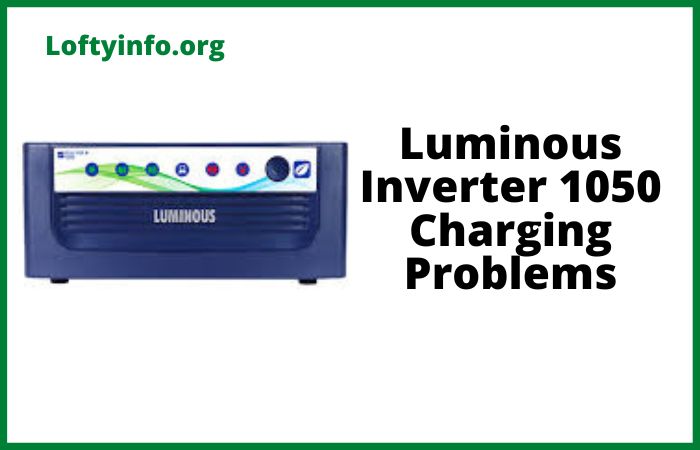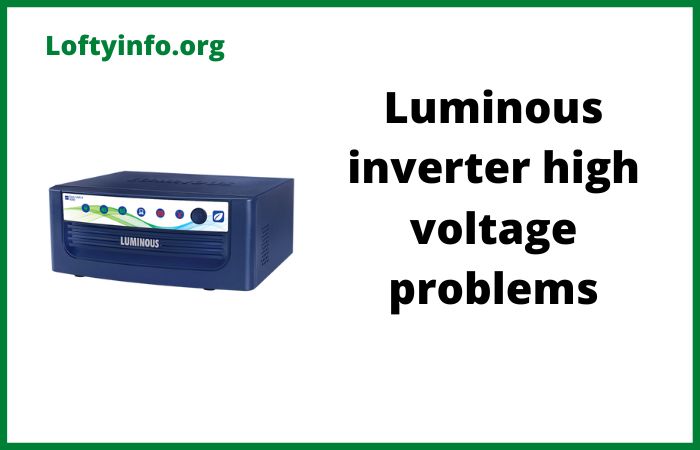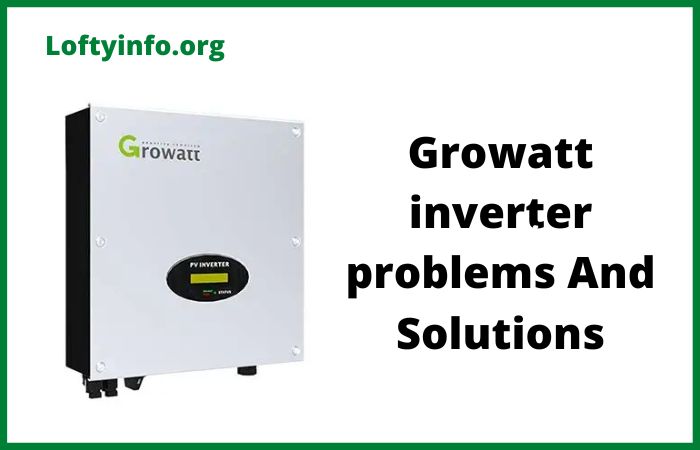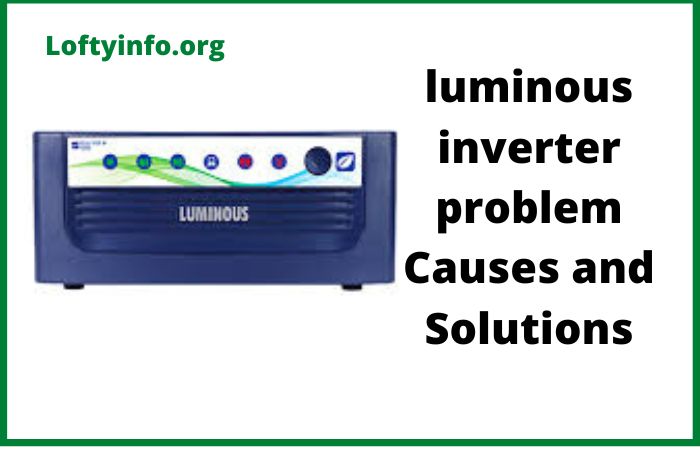Luminous Inverter 1050 Charging Problems: Major Causes and Solutions
The Luminous inverter 1050 is a reliable power backup solution, but like any electronic device, it can experience charging issues that affect its performance.
When your Luminous 1050 inverter fails to charge properly, it can leave you without backup power when you need it most.
Understanding the root causes of these charging problems is essential for maintaining optimal inverter performance and ensuring uninterrupted power supply.
If you’re experiencing charging issues with your Luminous inverter 1050, this comprehensive guide will help you identify and resolve the most common problems.
From battery related issues to electrical faults, we’ll explore major causes that can prevent your inverter from charging effectively.
Causes Of Luminous Inverter 1050 Charging Problems
1. Faulty or Aged Battery Performance
The most frequent cause of charging problems in Luminous inverter 1050 units stems from battery-related issues.
Over time, inverter batteries naturally degrade and lose their ability to hold charge effectively. When batteries age beyond their optimal lifespan of 3-5 years, they develop internal resistance that prevents proper charging cycles.
Dead cells within the battery are another common culprit.
A single dead cell in a 12V battery can drop the voltage significantly, making it impossible for the inverter’s charging circuit to function correctly.
The charging system may detect this voltage drop and either charge very slowly or stop charging altogether to protect the system.
Battery sulfation occurs when lead-acid batteries remain discharged for extended periods. This creates lead sulfate crystals on the battery plates, reducing the battery’s capacity and charging efficiency.
Signs of this problem include the battery taking unusually long to charge or failing to reach full capacity even after extended charging periods.
Solution: Test your battery voltage using a multimeter.
A healthy 12V battery should read around 12.6-12.8V when fully charged.
If readings are consistently low or if the battery is over 4 years old, consider replacement. Regular maintenance charging and avoiding deep discharge cycles can prevent premature battery failure.
2. Defective Charging Circuit Components
The charging circuit in your Luminous inverter 1050 contains several critical components that can fail over time.
The most vulnerable component is often the charging transformer, which steps down the AC voltage to appropriate levels for battery charging.
When this transformer develops winding faults or insulation breakdown, it can completely stop the charging process or cause irregular charging patterns.
Rectifier diodes within the charging circuit convert AC to DC for battery charging.
These semiconductor components can fail due to power surges, overheating or normal wear. A failed rectifier diode will prevent proper DC conversion, resulting in inadequate charging voltage reaching the battery.
The charging control IC (integrated circuit) manages the entire charging process, monitoring battery voltage and controlling charging current.
When this component malfunctions due to power fluctuations or component aging, it can cause erratic charging behavior, including premature charging cutoff or failure to initiate charging cycles.
Solution: These internal component failures require professional diagnosis and repair. Contact an authorized Luminous service center for proper testing and replacement of defective charging circuit components.
Attempting DIY repairs on these components can void your warranty and create safety hazards.
3. Loose or Corroded Battery Connections
Poor electrical connections between your inverter and battery are responsible for numerous charging problems.
Battery terminals naturally develop corrosion over time due to hydrogen gas emission during charging cycles.
This white, powdery buildup creates electrical resistance that impedes current flow between the inverter and battery.
Loose terminal connections can cause intermittent charging issues where the system appears to work sporadically.
Vibrations from nearby equipment or thermal expansion and contraction can gradually loosen connections, creating high-resistance joints that generate heat and further degrade the connection quality.
Damaged or undersized connecting cables also contribute to charging problems.
Cables that are too thin for the current requirements will develop voltage drops that prevent adequate charging voltage from reaching the battery.
Physical damage to cable insulation can create short circuits or ground faults that trigger the inverter’s protection systems.
Solution: Regularly inspect and clean battery terminals using a wire brush and baking soda solution to remove corrosion.
Ensure all connections are tight and properly torqued according to manufacturer specifications.
Replace damaged cables with appropriately sized conductors, typically 10-16 AWG for most residential inverter applications.
4. Voltage Fluctuations and Input Power Issues
Unstable mains voltage is a significant factor affecting inverter charging performance.
When input voltage fluctuates beyond the acceptable range (typically 160-270V for most inverters), the charging circuit may shut down to protect internal components.
Frequent voltage variations can also stress the charging components, leading to premature failure.
Low voltage conditions force the inverter’s charging circuit to work harder to maintain proper charging current, often resulting in overheating and reduced efficiency.
During brown-out conditions, the inverter may enter a protective mode that suspends charging operations until stable voltage returns.
Power supply interruptions and frequent grid failures prevent the inverter from completing full charging cycles.
Incomplete charging cycles can lead to battery sulfation and reduced capacity over time. Additionally, power factor issues and harmonic distortion in the electrical supply can affect the inverter’s ability to extract clean power for charging operations.
Solution: Install a voltage stabilizer or surge protector to regulate input voltage within acceptable limits.
Monitor your local power quality and consider upgrading your electrical supply if chronic voltage problems persist.
Use a digital multimeter to regularly check input voltage levels and identify patterns in power quality issues.
5. Overheating and Thermal Protection Activation
Excessive heat buildup is a critical factor that can halt charging operations in your Luminous inverter 1050.
When internal temperatures exceed safe operating limits, thermal protection circuits automatically shut down charging to prevent component damage.
This safety mechanism protects the inverter but leaves you without charging capability until temperatures normalize.
Poor ventilation around the inverter installation area is the primary cause of overheating issues.
Inverters generate significant heat during charging and discharging cycles, requiring adequate airflow to dissipate this thermal energy.
Installations in closed cabinets, near heat sources or in dusty environments compound thermal management problems.
Internal component aging can also increase heat generation.
As electronic components degrade, they often develop higher internal resistance, converting more electrical energy into waste heat.
Cooling fan failure in inverters equipped with active cooling systems will rapidly lead to overheating and charging shutdown.
Solution: Ensure minimum clearance requirements around your inverter installation (typically 6 inches on all sides).
Clean dust buildup from ventilation grilles and internal components regularly. Check cooling fan operation and replace if necessary.
Consider relocating the inverter to a cooler, well-ventilated area if chronic overheating occurs.
6. Control Panel and Display Malfunctions
The control panel and display system of your Luminous inverter 1050 can develop faults that affect charging operations.
While these components don’t directly handle power, they control the charging logic and provide crucial feedback about system status.
When the control panel malfunctions, it may incorrectly interpret battery status or fail to initiate proper charging sequences.
Software glitches in the inverter’s control system can cause charging algorithms to behave erratically.
These issues might manifest as premature charging termination, failure to start charging cycles, or incorrect battery status displays.
Power supply problems to the control circuitry can also cause similar symptoms.
Physical damage to the control panel from moisture, impacts, or electrical surges can disrupt communication between the user interface and the main charging control system.
Button failures or display malfunctions may prevent you from properly configuring charging parameters or monitoring system status.
Solution: Try performing a system reset by disconnecting all power sources for 10-15 minutes, then reconnecting.
Check for any error codes displayed on the panel and consult your user manual for specific troubleshooting steps.
If control panel problems persist, professional service is typically required to diagnose and repair or replace the control board.
Prevention and Maintenance Tips
Regular maintenance significantly reduces the likelihood of charging problems in your Luminous inverter 1050.
Schedule monthly visual inspections of all connections, quarterly battery voltage checks, and annual professional servicing to catch potential issues early.
Maintain proper battery water levels in flooded lead-acid batteries, keep terminals clean and properly tightened and ensure adequate ventilation around the inverter installation.
Monitor charging patterns and investigate any unusual behavior promptly to prevent minor issues from becoming major failures.
Consider investing in a digital multimeter and basic electrical testing equipment to perform routine diagnostics.
Understanding normal operating parameters for your specific system will help you identify problems before they cause complete charging failure.
By addressing these six major causes of charging problems systematically, you can restore reliable operation to your Luminous inverter 1050 and ensure consistent backup power availability.
Remember that complex electrical issues should always be handled by qualified technicians to ensure safety and maintain warranty coverage.
why luminous inverter low battery problem occurs
why inverter batteries get hot when charging
Solutions to luminous inverter low voltage problems
Luminous inverter troubleshooting
Why is luminous inverter fan not stopping
Luminous inverter charging problem
Common 3116 cat engine problems
Inverter battery charging problem causes and solutions
How to make tubular inverter battery last for a long time
Causes of luminous inverter voltage fluctuation problem
Why you should not charge lithium iron phosphate battery with car alternator






